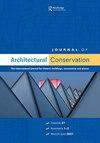Heritage in fragments: on spolia and other forms of preservation of architectural fragments through reuse
IF 0.5
3区 艺术学
0 ARCHITECTURE
引用次数: 1
Abstract
ABSTRACT This paper elaborates on the reuse of architectural fragments in new constructions as a strategy for the conservation of cultural heritage. The ancient practice of spolia is used as a frame of reference to analyze contemporary reflections and examples. The introduction reflects on the tension between the practice of spolia and heritage conservation. Next, a review of relevant literature is presented, including sources from different disciplinary backgrounds, like heritage conservation, architectural history, architectural theory, and interior architecture. Furthermore, two precedent-setting studies are investigated: the decomposition of the interiors of the Generale Bank in Brussels (Belgium) by Rotor and the reuse of its fragments in new projects, and the Lin'an History Museum in Hangzhou, China by Amateur Architecture Studio. The following research questions steered the investigations: (1) what is the origin of the spolia? (2) how are the spolia reintegrated into a new building? (3) is the heritage embedded in the spoliated fragment transferred to or appropriated by the new host? A final reflection highlights gaps in the literature study and proposes directions for future research.碎片中的遗产:通过再利用保护建筑碎片的孢子虫和其他形式
摘要本文阐述了建筑碎片在新建筑中的再利用作为文化遗产保护的一种策略。斯波利亚的古代实践被用作分析当代反思和例子的参照系。引言反映了斯波利亚实践与遗产保护之间的紧张关系。接下来,对相关文献进行了综述,包括来自不同学科背景的文献,如遗产保护、建筑史、建筑理论和室内建筑。此外,还调查了两项开创先例的研究:Rotor对比利时布鲁塞尔将军银行内部的分解及其碎片在新项目中的再利用,以及Amateur Architecture Studio对中国杭州临安历史博物馆的研究。以下研究问题指导了调查:(1)孢子虫的起源是什么?(2) 斯波利亚是如何重新融入一座新建筑的?(3) 孢子碎片中嵌入的遗产是转移给新宿主还是被新宿主侵占?最后的反思突出了文献研究中的空白,并为未来的研究提出了方向。
本文章由计算机程序翻译,如有差异,请以英文原文为准。
求助全文
约1分钟内获得全文
求助全文

 求助内容:
求助内容: 应助结果提醒方式:
应助结果提醒方式:


